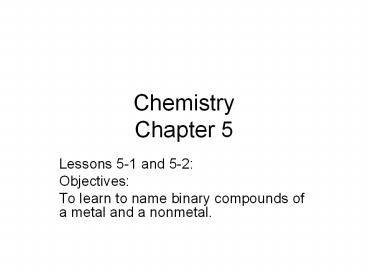Chemistry Chapter 5 - PowerPoint PPT Presentation
1 / 28
Title:
Chemistry Chapter 5
Description:
Chemistry Chapter 5 Lessons 5-1 and 5-2: Objectives: To learn to name binary compounds of a metal and a nonmetal. Binary compounds TWO BROAD CLASSES Compounds that ... – PowerPoint PPT presentation
Number of Views:49
Avg rating:3.0/5.0
Title: Chemistry Chapter 5
1
ChemistryChapter 5
- Lessons 5-1 and 5-2
- Objectives
- To learn to name binary compounds of a metal and
a nonmetal.
2
Binary compounds
- TWO BROAD CLASSES
- Compounds that contain a metal and a nonmetal
(Type I and Type II) - Compounds that contain 2 nonmetals
- (Type III)
3
BINARY IONIC Compounds
- A compound that results from the combination of a
metal with a nonmetal. - -The positive ion (cation) gets written first
- -To name these compounds, just name the ions.
4
In summary
- Type I compounds The metal present forms only
one type of cation. - Type II compounds The metal present can form 2
or more cations that have different charges.
5
Table 5.1
6
Rules for Naming Type I Ionic Compounds
- The cation is always named first and the anion
second. - A simple cation (obtained from a single atom)
takes its name form the name of the element. For
example Na is called sodium in the names of
compounds containing this ion. - A simple anion (obtained from a single atom) is
named by taking the first part of the element
name (the root) and adding ide.
7
Practice
- Compound Ions Present Name
- NaCl
- KI
- CaS
- CsBr
- MgO
Individual Practice Open to p. 87-88 Do
Self-Check Exercise 4-1 Complete for HW
8
Table 5.2
9
Common Names - Exceptions
- H2O water, steam, ice
- NH3 ammonia
- CH4 methane
- NaCl table salt
- C12H22O11 table sugar
10
Objectives
- Quiz on Type II cations
- Identify the rules for Type III binary compounds
(nonmetals) - Practice naming Type II binary ionic compounds
and Type III binary compounds
11
Examples for Type II binary ionic compounds
- Example Systematic Name Older Name
- Fe2O3
- CuCl2
- HgBr2
- PbI4
ferric oxide
iron(III)oxide
cupric chloride
copper(II) chloride
mercuric bromide
mercury(II) bromide
lead(IV) iodide
plumbic iodide
12
Naming Binary Compounds that Contain Only
Nonmetals (Type III)
- Objective To learn how to name binary compounds
containing nonmetals
13
Naming Binary Compounds that Contain Only
Nonmetals (Type III)
Similar to naming other binary compounds
EXCEPT Type III Binary compounds contain ONLY
NONMETALS
14
Naming Binary Compounds that Contain Only
Nonmetals (Type III)
- The 1st element in the formula is named 1st, and
the full element name is used. - The 2nd element is named as though it were an
anion. - Prefixes are used to denote the numbers of atoms
present. (mono-, di-, tri-, tetra-, penta-,
hexa-, hepta-, octa) - The prefix mono- is never used for naming the 1st
element. (Ex. CO carbon monoxide, not monocarbon
monoxide).
15
Naming Binary Compounds that Contain Only
Nonmetals (Type III)
I2O7 CO2 CF4 NH3 PCl3 BF3 NO N2O5
diiodine heptoxide
carbon dioxide
carbon tetrafluoride
ammonia
phosphorous trichloride
boron trifluoride
nitrogen oxide
dinitrogen pentoxide
S
16
Examples for Type II binary ionic compounds
- Example Systematic Name Older Name
- Fe2O3
- CuCl2
- HgBr2
- PbI4
ferric oxide
iron(III)oxide
cupric chloride
copper(II) chloride
mercuric bromide
mercury(II) bromide
lead(IV) iodide
plumbic iodide
17
Naming Binary Compounds A Review
- Objectives To review the naming of Type I, II,
and Type III binary compounds
18
Figure 5.1 A flow chart for naming binary
compounds.
19
Naming Compounds that Contain Polyatomic Ions
- Objective To learn the names of the common
polyatomic ions and how to use them in naming
compounds
20
LEARN THIS TABLE
Oxyanions contain different numbers of oxygen
atoms
21
Oxyanions contain different numbers of oxygen
atoms Smaller number of oxygen atoms
-ite Larger number of oxygen atoms
-ate Prefixes are used when there are more than
2 Hypo (less than) Per ( more than)
Example ClO hypochlorite
ClO2 chlorite
ClO3 chlorate
ClO4 perchlorate
22
Practice Naming these compounds
copper(II) nitrate
- Cu(NO3)2
- PbCO3
- KHSO4
- NH4I
- NaCN
lead(II) carbonate
potassium hydrogen sulfate
ammonium iodide
sodium cyanide
23
Figure 5.2 Overall strategy for naming chemical
compounds.
24
Naming Acids
- Objectives
- 1) To learn how the anion composition determines
the acids name. - 2) To learn names for common acids.
25
Acids
- Acids certain molecules produce H ions. An
acid can be viewed as a molecule with one or more
H ions attached to an anion.
26
Naming Acids
- Rules
- If the anion does not contain Oxygen, the acid is
named with the prefix hydro- and the suffix ic
attached to the root of the element.
Example HCl
hydrochloric acid
27
Naming Acids
- 2) When the anion contains Oxygen, the acid name
is formed from the root name of the central
element with a suffix of ic or ous. When the
anion ends in ate, the suffix-ic is used. When
the anion ends in ite the suffix, ous is used
Example H2SO4
sulfuric acid
Example H2SO3
sulfurous acid
28
Name these Acids
hydrofluoric acid
HF H3PO4 HNO3 HBrO4 H2S
phosphoric acid
nitric acid
bromic acid
hydrosulfuric acid
p.109 Question 24































